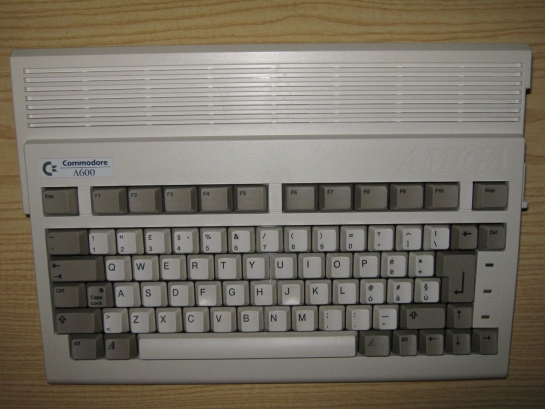
Autopsy:
Description:
- Country: Usa
- Most Common: Usa/Europe
- Rarity: Unrare
- Year: 1992
from Wikipedia:
The Amiga 600, also known as the A600 (codenamed “June Bug” after a B-52′s song), was a home computer introduced at the CeBIT show in March 1992.
The A600 was the final model of the original A500-esque line based around the Motorola 68000 CPU and the ECS chipset. A notable aspect of the A600 was its small size. Lacking a numeric keypad, the A600 was 14″ long by 9.5″ deep by 3″ high and weighed approximately 6 pounds. AmigaOS 2.0 was included which was generally considered more user-friendly than AmigaOS 1.3.
source: Wikipedia
Autopsy:
Description:
- Country: Usa
- Most Common: Usa/Europe
- Rarity: Unrare
- Year: ????
from Wikipedia:
The Commodore 1530 (C2N) Datasette (a portmanteau of data and cassette), was Commodore’s dedicated computer tape recorder.
It provided access to an inexpensive storage medium for Commodore’s 8-bit home/personal computers, notably the PET, VIC-20, and C64. A physically similar model Commodore 1531 was made for the Commodore 16 and Plus/4 series computers.
source: Wikipedia
Gallery / Autopsy:
Stuff Donated:
- 1 x Amiga 500 with 512k expansion and Kickstart Switch.
- 1 x Joystick Quickshot II Plus.
- 2 x Joystick Slik Stik from Suncom.
- 1 x New Genlock from Logica
- 2 x Amiga 500 Mouse.
- 2 x Amiga 500 Powersupply.
- 2 x 1084S Amiga 500 Cables.
- 1 x Scart Amiga 500 Cable.
- 1 x RF Cable.
- 2 x Amiga 520 Modulator.
- 1 x Amiga Eye Video Digitizer.
- 2 x Bulk Joystick.
- Amiga Workbench Disk (Original).
Thanks to Piero.
from Wikipedia:
The Amiga 500, also known as the A500, was the first “low-end” Commodore Amiga 16/32-bit multimedia home/personal computer. It was announced at the winter Consumer Electronics Show in January 1987, at the same time as the high-end Amiga 2000, and competed directly against the Atari 520ST. The A500 was released in mid 1987 at the price of 595.95 USD without monitor.
source: Wikipedia
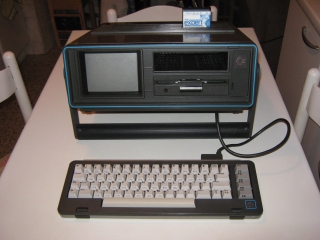
Autopsy:
Description:
- Country: USA
- Most Common: USA/Europe
- Rarity: Very rare
- Year: 1983
- Price: $995
Fix/Enhancement:
- Added a Fan.
- ASSY fix from Commodore.
- I/O Fastloader fix.
- Userport GND fix.
- Jiffy Kernel (C64/1541).
from Wikipedia:
The Commodore SX-64, also known as the Executive 64, or VIP-64 in Europe, was a portable, briefcase/suitcase-size “luggable” version of the popular Commodore 64 home computer and holds the distinction of being the first full-color portable computer.
The SX-64 featured a built-in five-inch composite monitor and a built-in 1541 floppy drive. It weighed 23 lb (10.5 kg). The machine was carried by its sturdy handle, which doubled as an adjustable stand. It was announced in January 1983 and released a year later, at $995.
source: Wikipedia Oldcomputers
Autopsy:
The Sega MasterSystem II was originally designed to output an RF modulated (VHF) signal but with a mod you can get a better signal with the Composite Video .
Description:
- Country: Japan
- Most Common: Usa/Europe
- Rarity: Unrare
- Year: 1990
from Wikipedia:
The Sega Master System is an 8-bit cartridge-based video game console that was manufactured by Sega and was first released in 1986.[3] Its original Japanese incarnation was the Sega Mark III (although the “Master System” name has also been used in Japan).
In the European market, this console launched Sega onto a competitive level comparable to Nintendo, due to its wider availability, but failed to put a dent in the North American and Japanese markets. The Master System was released as a direct competitor to the NES/Famicom.
source: Wikipedia
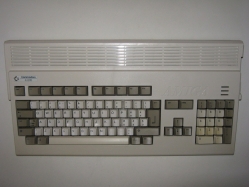
Autopsy:
Description:
- Country: USA
- Most Common: USA/Europe
- Rarity: Unrare
- Year: 1991-92
from Wikipedia:
The Amiga 1200, or A1200, was Commodore International’s third-generation Amiga computer, aimed at the home market. It was launched in October 21, 1992, at a base price of £399 in the United Kingdom and $599 in the United States. Initially, only 30,000 A1200s were available at the UK launch.[1]
Like its predecessor, the Amiga 500, the A1200 is an all-in-one design incorporating the CPU, keyboard, and disk drives (including, unlike the A500, the option of an internal hard disk drive) in one physical unit. The machine was designed to be able to house a 2.5inch HDD internally, but it was possible to mount a 3.5inch HDD inside the 1200 if a little brute force was used.
source: Wikipedia
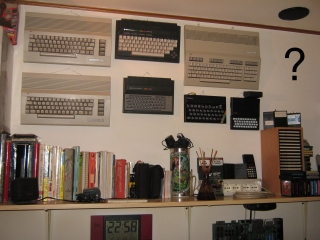
Art of Commodore Part1
Description from Left to Right:
- Commodore 64 II Generation Two (New Keyboard style/Mainboard with 8580)
- Commodore 64 II Generation One (Old Keyboard style/Mainboard with 6581)
- Commodore Plus 4
- Commodore 116
- Commodore 128
- ZX Spectrum 48k
- ZX 81 + 16k
* there are two lame computers in this photo! ;-D
Autopsy:
I have also a tape drive Datasette (black), tape drive adapter, manual, and joystick adapter.
Description:
- Country: USA
- Most Common: Europe
- Rarity: Rare
- Year: 1984
The low end members of the 264 series are the Commodore 16 and the Commodore 116. Of all the machines showcased at the C.E.S., the C116 was the only model to make it to store shelves as originally designed; though it was only in Europe, and in very small numbers.
The Commodore 116 was originally slated to be the only machine in this series, and was designed by engineers at Commodore-US.
source: Zimmers.net
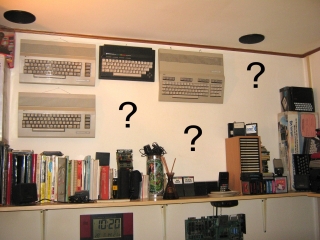
Art of Commodore Part1
Description from Left to Right:
- Commodore 64 II Generation Two (New Keyboard style/Mainboard with 8580)
- Commodore 64 II Generation One (Old Keyboard style/Mainboard with 6581)
- Commodore Plus 4
- Commodore 128
This is a Very old “Programmable” Joystick Interface for ZX Spectrum from AGF ©1983. You must see that it’s very easy to use. :-D
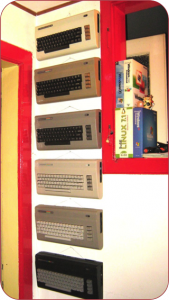
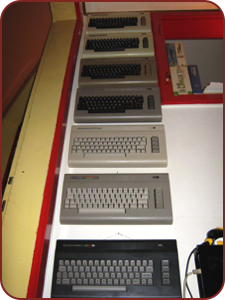
I have hung some commodore on the wall like paintings, i have others to hang…but my room is very small.
Description from top:
- Commodore VIC-20 Generation One (Pet Function key style)
- Commodore VIC-20 Generation Two
- Commodore 64 Generation One (Pet Function key style)
- Commodore 64 Generation Two (The classic one)
- Commodore 64 G
- Commodore 64 Aldi
- Commodore 16
The CheapLPC is a flashrom burner for the SST49LF020 chip, The Software can read back, and verify the contents of the chip.
The software is also compatible with any other CheapLPC based programmer, like that used in the Martrix by Xodus, Ozx Prog by OZx Modchips, Neurosys, and a few others.
Download: GreenProg (CheapLPC Programmer) v0.7 (1228)
source: wikipedia cheaplpc.com
Description:
- Country: USA
- Most Common: Europe
- Rarity: Unrare
- Year: 1980
The VIC-20 was intended to be more economical than the PET computer. It was equipped with only 5 KB of RAM and used the same MOS 6502 CPU as the PET. The VIC-20′s video chip, the MOS Technology VIC, was a general-purpose color video chip designed by Al Charpentier in 1977 and intended for use in inexpensive display terminals and game consoles, but Commodore couldn’t find a market for the chip.
As the Apple II gained momentum with the advent of VisiCalc in 1979, Jack Tramiel wanted a product that would compete in the same segment, to be presented at the January 1980 CES. For this reason Chuck Peddle and Bill Seiler started to design a computer named TOI (The Other Intellect).
wiki: VIC20-Wiki










































































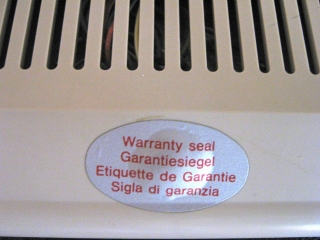


















Recent Comments